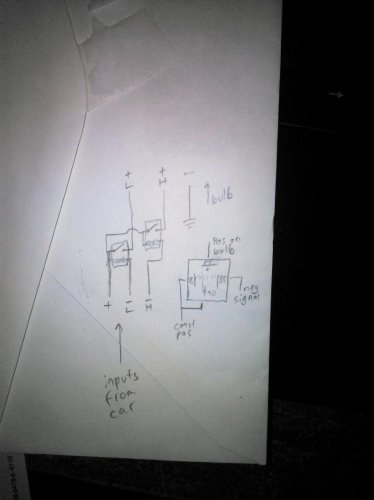http://www.ebay.com/itm/2X-Dual-col...Parts_Accessories&hash=item1c32287e81&vxp=mtr
Or will they require additional bastardization of the wiring?
Or will they require additional bastardization of the wiring?
Those are designed for a constant common ground and two separate switched powers (one for turn, and the other for parking).
The LS has constant common power and two separate switched grounds (one for turn, and the other for parking).
Im going to attempt it with 2 relays per side this spring once it warms up and I can work outside without a jacket and gloves... lol...I'm just going to give up on switchbacks.

View attachment 828471525
I think this should do it for you. 2 relays per side and an new ground connection. Clip all 3 wires at the plug. Connect the positive wire to pins 86 (coil) and 30 (relay switch). Connect the switched negative signal to pin 85 (coil). Pin 87 (relay switch) will now put out switched positive. Repeat 3 more times.
Connect the appropriate switched positive outputs to the former switched negative wires on the bulb connector. Connect the new body-negative to the old positive wire on the connector.
You'll probably need load resistors bridging positive to high/blinker/major negative to cancel the bulb out warning.
resistors are the trick to make this work properly, no ones been able to get it quite right yet.
1st gen is different from 2nd gen too FYI
Thanks for this LSFrank. However, this looks like Chinese translated into Portuguese translated into a dead language to me. I'm like a girl when it comes to electrical stuff. I know how to plug stuff in and turn it on and off. That's about it. LOL

1st gen is different from 2nd gen too FYI
Takes more than resistors for these. It'll take at least two resistors and two relays (or some transistors) per side to make those LEDs work on the LS.
...I would think the forward voltage of a transistor would hurt the already-poor performance of drop-in LED retrofits. LED clusters tend to put out light in the wrong spot for the reflectors, so reducing the voltage and making them dimmer would only hurt performance more....
View attachment 828471525
asshole..... lmfaoooo
I think this should do it for you. 2 relays per side and an new ground connection. Clip all 3 wires at the plug. Connect the positive wire to pins 86 (coil) and 30 (relay switch). Connect the switched negative signal to pin 85 (coil). Pin 87 (relay switch) will now put out switched positive. Repeat 3 more times.
Connect the appropriate switched positive outputs to the former switched negative wires on the bulb connector. Connect the new body-negative to the old positive wire on the connector.
You'll probably need load resistors bridging positive to high/blinker/major negative to cancel the bulb out warning.
View attachment 828471525
